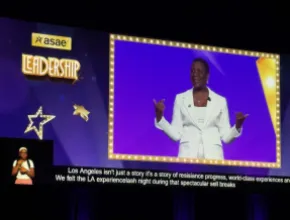Anyone who’s fidgeted their way through a boring conference lecture—in actuality, probably just about everyone—knows the value of attendee engagement to the retention of knowledge, and the Internet Age is just exacerbating the need.
Call it “short attention-span theater.” Everyone’s had a role on that stage, but many people who work in the meetings and conventions industry are trying to ride to the rescue by improving the attendee experience.
“Audiences are demanding it,” contends Jeff Hurt, executive vice president of education and engagement for Velvet Chainsaw Consulting, which helps companies and associations improve the content and engagement at their annual meetings, conferences, education and events. “Sociologists call today’s culture the participatory culture, as the Internet has changed the way we operate. We control how long and fast we do things, and if it doesn’t hold our attention, we click out of it and go on to something else.”
The next time you’re at a conference just look around at all of the people tooling about on mobile devices. That’s a case-in-point for the increasing inability of humans to sit still and sponge up knowledge passively.
In fact, Hurt says that the typical human attention span is about 10 minutes, and that the first 30 seconds is critical to creating that “what’s in it for me” moment to even begin to keep them engaged. Then, he says, the next four minutes represents the next significant attention threshold.
“When you take an audience and put them in an educational session, and ask them to sit quietly and passively for a long amount of time, it is contrary to the world today,” Hurt adds. “It’s actually contrary to how our brain learns. Lecturing has the lowest return of all the senses.”PageBreak
Hurt says that even adding something as simple as a discussion element helps to increase engagement.
Some industry observers believe a big barrier to creating an engaging attendee environment is the paramount importance many meeting planners place on the logistics side of their jobs. Weighting the logistics side of meeting planner to heavily could end up hurting the conference in the end, according to Hurt.
“Logistics have become a commodity, and doing good logistics is not competitive in a conference environment,” Hurt says. “You don’t return to a conference because the registration went smoothly. You return to a conference because it met your needs. Conference hosts need to rethink what they’re doing or attendance will decline.”
Jeffrey Cufaude, president and CEO of Idea Architects, which also consults on improving the attendee experience, agrees that meeting planners are typically extremely detailed people, so relatively non-linear concepts such as improving learning and networking environments can take a back seat to getting the nuts and bolts of the meeting correct.
“People have been talking about this for so long,” Cufaude says. “The only thing I’ve been able to discover is that the people who are pure planners—who are very detailed-oriented and analytical—are driven by checklists. If we want them to think about these things, we need to create better checklists for them, and that means our hotel partners, too. Maybe what we need to do is create a new template for news systems, so people who are incredibly efficient at executing are working off a better list.”
Cufaude, who also wrote a column about attendee engagement for PCMA for seven years, says that the MPI Foundation just concluded a study about the future of meetings that addresses attendee engagement, and that many of the other meetings industry associations are discussing the topic. Another resource he recommends is The Masie Center (http://masie.com) and its Learning 2012 event, happening Oct. 21-24 in Orlando and bringing together corporate, association and government conference designers, along with speaker Gen. Colin Powell Ret. and top authors on the subject of learning and conference design.
Cufaude says that current trends include not using theater settings, but instead using round tables to sit attendees at, and also experimenting with varying time blocks for sessions, along with different room sets and more-informal learning.
In the end, he contends, the landscape is also slow to change because of the way conference organizers evaluate meetings.
“When do we make change?” he asks. “When our customers demand it…and I haven’t seen anyone walk out of a lecture complaining about the format.”PageBreak
Hurt agrees that the meetings industry has been kicking around the topic of attendee engagement for 15 or 20 years, and it’s just now that conference organizers are really starting to implement format changes. Much of this, he says, is that about 20 years ago most directors of meetings were also directors of education, and it’s starting to shift back to that dynamic.
Major new trends, according to Hurt, include the phenomenon of tweeting during conferences, and that it actually aids learning; TED-style talks; and keynotes that are less monologue and more sit-down interview.
“There are more peer-to-peer conversations during a general session,” he says. “It’s no longer about the subject matter experts. It’s about the subject matter experience. We have to mine for that; to find ways to share stories between peers.
Hurt also is an advocate of “adult white space,” which is a nod to the graphics industry in that having less quantity of content, but with more focus, draws attention to primary objectives.
“For a long time we’ve thought that the more content we can put into a conference the better off we are, but research shows that the opposite is true—more-focused content with more time to reflect on it,” he contends, adding that neuroscience studies point to conference organizers featuring breaks that are longer than the relatively typical 15 minutes.
“Try 30-minute breaks on the first day, 45-minute breaks on the second and an hour on the third day,” he says. “During those breaks the pre-convene areas of hotels are used to have conversations, with lots of informal gatherings, but have facilitators there to lead the discussion—there’s more intentionality around that for a higher level of engagement.”






